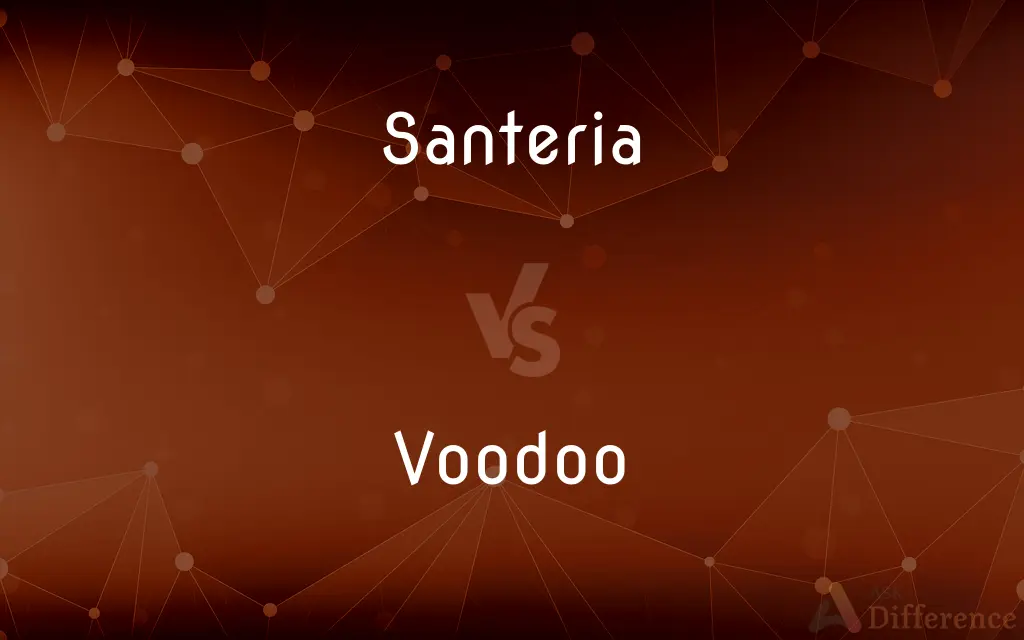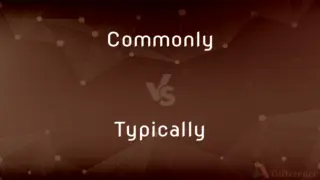Santeria vs. Voodoo — What's the Difference?
By Maham Liaqat & Urooj Arif — Published on March 7, 2024
Santería, rooted in Yoruba beliefs and Roman Catholicism, focuses on building relationships with Orishas. Voodoo, with West African, Catholic, and Native American influences, centers on spirits, ancestors, and magic practices.

Difference Between Santeria and Voodoo
Table of Contents
ADVERTISEMENT
Key Differences
Santería, also known as Regla de Ocha, originates from the Yoruba people of West Africa and was developed in Cuba among enslaved Africans. It blends Yoruba mythology, Roman Catholicism, and indigenous American traditions, focusing on the worship of Orishas, deities that represent natural forces and human endeavors. Practitioners believe in a supreme god, Olodumare, and engage in rituals involving music, dance, animal sacrifice, and divination to communicate with Orishas for guidance and support.
Voodoo, or Vodou, primarily found in Haiti and parts of the United States, especially Louisiana, combines elements from West African Vodun, Catholicism, and aspects of Native American spirituality. It is a community-centric religion emphasizing the veneration of Lwa (spirits) and ancestors, who play an active role in the lives of believers. Voodoo rituals often include singing, dancing, drumming, and offerings to connect with the spirit world, seeking protection, healing, and advice. Magic and the creation of talismans or amulets are also significant aspects, aimed at harnessing spiritual forces for various purposes.
Both religions practice animal sacrifice and possess a pantheon of spiritual beings, but their cosmologies, rituals, and purposes show distinct differences. Santería's rituals are more closely aligned with achieving harmony and guidance in life through the intercession of Orishas, whereas Voodoo's practices focus on direct communication with spirits and ancestors for protection, healing, and community well-being.
The perception and representation of both religions have been affected by sensationalized media portrayals, often emphasizing exotic or supernatural elements over their rich cultural and spiritual depth. Despite facing stigma and misunderstanding, both Santería and Voodoo have vibrant communities of practitioners committed to preserving their traditions and beliefs.
Comparison Chart
Origins
Yoruba people of West Africa, developed in Cuba
West African Vodun, developed in Haiti
ADVERTISEMENT
Influences
Yoruba mythology, Roman Catholicism, indigenous American traditions
West African Vodun, Catholicism, Native American spirituality
Supreme Being
Olodumare
Bondye (remote supreme deity)
Deities/Spirits
Orishas, intermediaries between humans and Olodumare
Lwa, spirits serving as intermediaries between humans and Bondye
Rituals
Music, dance, animal sacrifice, divination
Singing, dancing, drumming, offerings, magic practices
Purpose
Guidance, support, harmony with Orishas
Protection, healing, community well-being through spirits and ancestors
Magic
Less emphasis on magic, more on divination and sacrifice
Significant role of magic, talismans, and amulets
Cultural Context
Cuban, with Yoruba and Catholic elements
Haitian, with African, Catholic, and Native American elements
Compare with Definitions
Santeria
Utilizes music and dance in rituals.
Santería rituals are vibrant, with drumming and dancing to honor Orishas.
Voodoo
A religion with African, Catholic, and Native American roots.
Voodoo incorporates a rich tapestry of spiritual practices.
Santeria
Focuses on worshiping Orishas.
In Santería, each Orisha represents a natural force or human aspect.
Voodoo
Centers on the veneration of Lwa and ancestors.
Voodoo rituals serve to strengthen connections with the spirit world.
Santeria
A religion combining Yoruba. Catholic. and indigenous beliefs.
Santería practices involve rituals to connect with Orishas.
Voodoo
Uses magic and talismans.
Magic in Voodoo is used to create talismans for protection and good fortune.
Santeria
Seeks harmony and guidance.
Practitioners turn to Santería for spiritual guidance and to maintain balance in life.
Voodoo
Emphasizes community and healing.
Voodoo practices often focus on healing and protecting the community.
Santeria
Involves animal sacrifice for divination.
Animal sacrifices in Santería are offerings to seek Orishas' guidance.
Voodoo
Features singing and drumming in rituals.
Rituals in Voodoo are filled with singing and drumming to invite spirit presence.
Santeria
An African-based religion similar to voodoo, originating in Cuba, which combines the worship of traditional Yoruban deities with the worship of Roman Catholic saints.
Voodoo
A religion of West African origin practiced chiefly in Haiti and other Caribbean countries, based on animism, magic, and elements of Roman Catholic ritual, and characterized by belief in a supreme God and a large pantheon of local and tutelary deities, deified ancestors, and saints, who communicate with believers in dreams, trances, and ritual possessions. Also called vodoun.
Santeria
Alternative form of santería
Voodoo
A practitioner, priest, or priestess of voodoo.
Voodoo
The spiritual beliefs of the Ewe/Fon of West Africa, practiced chiefly in Benin and in the south of Togo.
Voodoo
(pejorative) Any sort of magical or irrational approach to a problem.
I want a real explanation, not this statistical voodoo.
Voodoo
One who practices voodooism; a negro sorcerer.
Voodoo
A charm superstitiously believed to embody magical powers
Voodoo
A religious cult practiced chiefly in Caribbean countries (especially Haiti); involves witchcraft and animistic deities
Common Curiosities
Can anyone practice Santería or Voodoo?
Both religions are open to new adherents, but entering these communities typically involves a period of learning, initiation, and participation in rituals.
What is Santería?
Santería is a syncretic religion that blends Yoruba mythology, Roman Catholicism, and indigenous American traditions, focusing on the worship of deities called Orishas.
How do Santería and Voodoo rituals differ?
Santería rituals involve music, dance, animal sacrifices, and divination to communicate with Orishas, while Voodoo rituals include singing, dancing, drumming, and offerings to connect with spirits and ancestors, along with the use of magic and talismans.
What is Voodoo?
Voodoo is a religion that combines elements of West African Vodun, Catholicism, and Native American spirituality, emphasizing the veneration of spirits called Lwa and ancestors.
How do practitioners of Santería and Voodoo view the afterlife?
Both religions believe in an afterlife where spirits continue to interact with the living, emphasizing the importance of ancestral veneration and the continued presence of spirits in the world.
Do Santería and Voodoo involve black magic?
The perception of "black magic" is a stereotype. Both religions have aspects of magic, but their practices are aimed at healing, protection, and positive outcomes for their communities.
What role does Catholicism play in Santería and Voodoo?
Catholicism has influenced both religions in the syncretism of beliefs and practices, including the incorporation of saints and Christian rituals, as a means of preserving African traditions under colonial repression.
How are Orishas different from Lwa?
Orishas in Santería are deities representing various aspects of life and nature, serving as intermediaries to the supreme god. Lwa in Voodoo are spirits also serving as intermediaries, but they have a more direct and personal involvement in practitioners' lives.
Are Santería and Voodoo recognized religions?
Yes, both are recognized as legitimate religions with rich spiritual and cultural traditions, despite facing misconceptions and stereotypes.
Is animal sacrifice common in both religions?
Yes, animal sacrifice is a ritual practice in both Santería and Voodoo, viewed as an offering to deities or spirits for blessings, guidance, and communication.
Share Your Discovery

Previous Comparison
Atomic Mass vs. Atomic Number
Next Comparison
Commonly vs. TypicallyAuthor Spotlight
Written by
Maham LiaqatCo-written by
Urooj ArifUrooj is a skilled content writer at Ask Difference, known for her exceptional ability to simplify complex topics into engaging and informative content. With a passion for research and a flair for clear, concise writing, she consistently delivers articles that resonate with our diverse audience.
















































